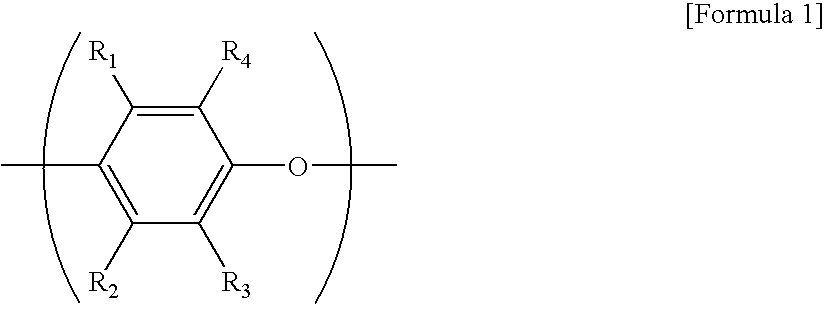Thermoplastic resin composition
a technology of thermoplastic resin and composition, applied in the field of thermoplastic resin composition, can solve the problems of poor oil resistance and molding workability of polyphenylene ether, dimensional discrepancies, etc., and achieve the effect of excellent dimensional stability
- Summary
- Abstract
- Description
- Claims
- Application Information
AI Technical Summary
Benefits of technology
Problems solved by technology
Method used
Image
Examples
examples
[0136]Hereinafter, the present invention will be described in detail with reference to Examples and Comparative Examples; however, the present invention is not limited to what are described in these examples.
(Raw Materials Used)
[0137]Raw materials used in Examples and the like are as follows.
(A) Polyamide (Hereinafter Abbreviated as PA)
(PA-1) Polyamide 6
[0138]Relative viscosity (98% sulfuric acid / 25° C.)=2.3 (JIS K6810)
[0139]Amino group / carboxyl group ratio (concentration ratio)=0.4
(PA-2) Polyamide 6,6
[0140]Relative viscosity (98% sulfuric acid / 25° C.)=2.6 (JIS K6810)
[0141]Amino group / carboxyl group ratio (concentration ratio)=0.3
(B) Polyphenylene Ether (Hereinafter Abbreviated as PPE as the Case may be)
(PPE-1) Polyphenylene ether
[0142]poly(2,6-dimethyl-1,4-phenylene ether) (manufactured by Asahi Kasei Chemicals Corp.)
[0143]Reduced viscosity: 0.42 dl / g (0.5 g / dl, chloroform solution, measured at 30° C.)
(PPE-2) Maleic anhydride-modified polyphenylene ether
[0144]Prepared by adding to ...
PUM
| Property | Measurement | Unit |
|---|---|---|
| particle size | aaaaa | aaaaa |
| particle size | aaaaa | aaaaa |
| particle size | aaaaa | aaaaa |
Abstract
Description
Claims
Application Information
 Login to View More
Login to View More - R&D
- Intellectual Property
- Life Sciences
- Materials
- Tech Scout
- Unparalleled Data Quality
- Higher Quality Content
- 60% Fewer Hallucinations
Browse by: Latest US Patents, China's latest patents, Technical Efficacy Thesaurus, Application Domain, Technology Topic, Popular Technical Reports.
© 2025 PatSnap. All rights reserved.Legal|Privacy policy|Modern Slavery Act Transparency Statement|Sitemap|About US| Contact US: help@patsnap.com

